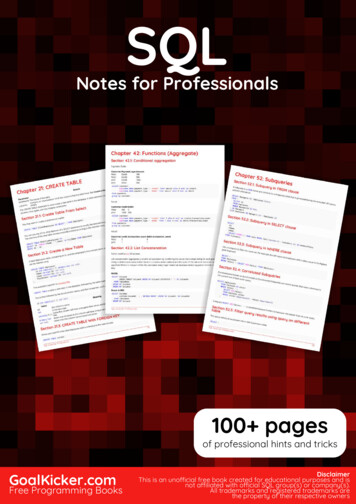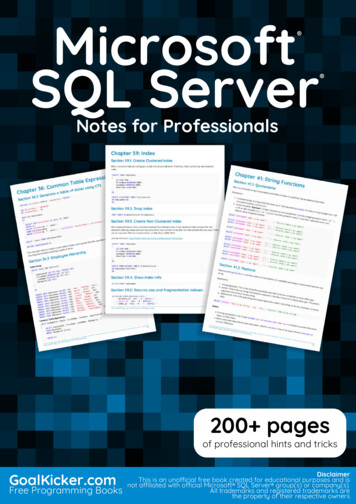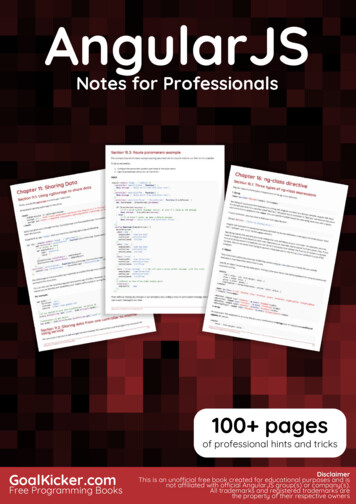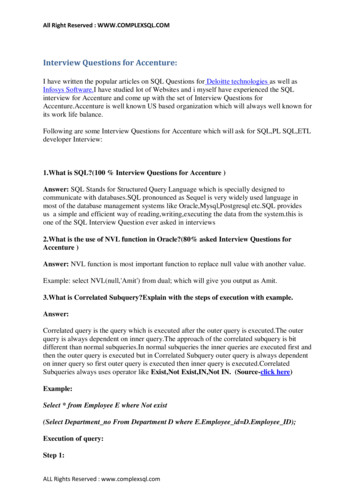
Transcription
SQLSQLNotes for ProfessionalsNotes for Professionals100 pagesof professional hints and tricksGoalKicker.comFree Programming BooksDisclaimerThis is an uno cial free book created for educational purposes and isnot a liated with o cial SQL group(s) or company(s).All trademarks and registered trademarks arethe property of their respective owners
ContentsAbout . 1Chapter 1: Getting started with SQL . 2Section 1.1: Overview . 2Chapter 2: Identifier . 3Section 2.1: Unquoted identifiers . 3Chapter 3: Data Types . 4Section 3.1: DECIMAL and NUMERIC . 4Section 3.2: FLOAT and REAL . 4Section 3.3: Integers . 4Section 3.4: MONEY and SMALLMONEY . 4Section 3.5: BINARY and VARBINARY . 4Section 3.6: CHAR and VARCHAR . 5Section 3.7: NCHAR and NVARCHAR . 5Section 3.8: UNIQUEIDENTIFIER . 5Chapter 4: NULL . 6Section 4.1: Filtering for NULL in queries . 6Section 4.2: Nullable columns in tables . 6Section 4.3: Updating fields to NULL . 6Section 4.4: Inserting rows with NULL fields . 7Chapter 5: Example Databases and Tables . 8Section 5.1: Auto Shop Database . 8Section 5.2: Library Database . 10Section 5.3: Countries Table . 12Chapter 6: SELECT . 14Section 6.1: Using the wildcard character to select all columns in a query . 14Section 6.2: SELECT Using Column Aliases . 15Section 6.3: Select Individual Columns . 18Section 6.4: Selecting specified number of records . 19Section 6.5: Selecting with Condition . 20Section 6.6: Selecting with CASE . 20Section 6.7: Select columns which are named after reserved keywords . 20Section 6.8: Selecting with table alias . 21Section 6.9: Selecting with more than 1 condition . 22Section 6.10: Selecting without Locking the table . 22Section 6.11: Selecting with Aggregate functions . 23Section 6.12: Select with condition of multiple values from column . 24Section 6.13: Get aggregated result for row groups . 24Section 6.14: Selection with sorted Results . 24Section 6.15: Selecting with null . 25Section 6.16: Select distinct (unique values only) . 25Section 6.17: Select rows from multiple tables . 25Chapter 7: GROUP BY . 27Section 7.1: Basic GROUP BY example . 27Section 7.2: Filter GROUP BY results using a HAVING clause . 28Section 7.3: USE GROUP BY to COUNT the number of rows for each unique entry in a given column. 28Section 7.4: ROLAP aggregation (Data Mining) . 29
Chapter 8: ORDER BY . 31Section 8.1: Sorting by column number (instead of name) . 31Section 8.2: Use ORDER BY with TOP to return the top x rows based on a column's value . 31Section 8.3: Customizeed sorting order . 32Section 8.4: Order by Alias . 32Section 8.5: Sorting by multiple columns . 33Chapter 9: AND & OR Operators . 34Section 9.1: AND OR Example . 34Chapter 10: CASE . 35Section 10.1: Use CASE to COUNT the number of rows in a column match a condition . 35Section 10.2: Searched CASE in SELECT (Matches a boolean expression) . 36Section 10.3: CASE in a clause ORDER BY . 36Section 10.4: Shorthand CASE in SELECT . 36Section 10.5: Using CASE in UPDATE . 37Section 10.6: CASE use for NULL values ordered last . 37Section 10.7: CASE in ORDER BY clause to sort records by lowest value of 2 columns . 38Chapter 11: LIKE operator . 39Section 11.1: Match open-ended pattern . 39Section 11.2: Single character match . 39Section 11.3: ESCAPE statement in the LIKE-query . 40Section 11.4: Search for a range of characters . 41Section 11.5: Match by range or set . 41Section 11.6: Wildcard characters . 41Chapter 12: IN clause . 43Section 12.1: Simple IN clause . 43Section 12.2: Using IN clause with a subquery . 43Chapter 13: Filter results using WHERE and HAVING . 44Section 13.1: Use BETWEEN to Filter Results . 44Section 13.2: Use HAVING with Aggregate Functions . 45Section 13.3: WHERE clause with NULL/NOT NULL values . 45Section 13.4: Equality . 46Section 13.5: The WHERE clause only returns rows that match its criteria . 46Section 13.6: AND and OR . 46Section 13.7: Use IN to return rows with a value contained in a list . 47Section 13.8: Use LIKE to find matching strings and substrings . 47Section 13.9: Where EXISTS . 48Section 13.10: Use HAVING to check for multiple conditions in a group . 48Chapter 14: SKIP TAKE (Pagination) . 50Section 14.1: Limiting amount of results . 50Section 14.2: Skipping then taking some results (Pagination) . 50Section 14.3: Skipping some rows from result . 51Chapter 15: EXCEPT . 52Section 15.1: Select dataset except where values are in this other dataset . 52Chapter 16: EXPLAIN and DESCRIBE . 53Section 16.1: EXPLAIN Select query . 53Section 16.2: DESCRIBE tablename; . 53Chapter 17: EXISTS CLAUSE . 54Section 17.1: EXISTS CLAUSE . 54Chapter 18: JOIN . 55
Section 18.1: Self Join . 55Section 18.2: Di erences between inner/outer joins . 56Section 18.3: JOIN Terminology: Inner, Outer, Semi, Anti. . 59Section 18.4: Left Outer Join . 68Section 18.5: Implicit Join . 69Section 18.6: CROSS JOIN . 70Section 18.7: CROSS APPLY & LATERAL JOIN . 70Section 18.8: FULL JOIN . 72Section 18.9: Recursive JOINs . 73Section 18.10: Basic explicit inner join . 73Section 18.11: Joining on a Subquery . 73Chapter 19: UPDATE . 75Section 19.1: UPDATE with data from another table . 75Section 19.2: Modifying existing values . 76Section 19.3: Updating Specified Rows . 76Section 19.4: Updating All Rows . 76Section 19.5: Capturing Updated records . 76Chapter 20: CREATE Database . 77Section 20.1: CREATE Database . 77Chapter 21: CREATE TABLE . 78Section 21.1: Create Table From Select . 78Section 21.2: Create a New Table . 78Section 21.3: CREATE TABLE With FOREIGN KEY . 78Section 21.4: Duplicate a table . 79Section 21.5: Create a Temporary or In-Memory Table . 79Chapter 22: CREATE FUNCTION . 81Section 22.1: Create a new Function . 81Chapter 23: TRY/CATCH . 82Section 23.1: Transaction In a TRY/CATCH . 82Chapter 24: UNION / UNION ALL . 83Section 24.1: Basic UNION ALL query . 83Section 24.2: Simple explanation and Example . 84Chapter 25: ALTER TABLE . 85Section 25.1: Add Column(s) . 85Section 25.2: Drop Column . 85Section 25.3: Add Primary Key . 85Section 25.4: Alter Column . 85Section 25.5: Drop Constraint . 85Chapter 26: INSERT . 86Section 26.1: INSERT data from another table using SELECT . 86Section 26.2: Insert New Row . 86Section 26.3: Insert Only Specified Columns . 86Section 26.4: Insert multiple rows at once . 86Chapter 27: MERGE . 87Section 27.1: MERGE to make Target match Source . 87Section 27.2: MySQL: counting users by name . 87Section 27.3: PostgreSQL: counting users by name . 87Chapter 28: cross apply, outer apply . 89Section 28.1: CROSS APPLY and OUTER APPLY basics . 89
Chapter 29: DELETE . 91Section 29.1: DELETE all rows . 91Section 29.2: DELETE certain rows with WHERE . 91Section 29.3: TRUNCATE clause . 91Section 29.4: DELETE certain rows based upon comparisons with other tables . 91Chapter 30: TRUNCATE . 93Section 30.1: Removing all rows from the Employee table . 93Chapter 31: DROP Table . 94Section 31.1: Check for existence before dropping . 94Section 31.2: Simple drop . 94Chapter 32: DROP or DELETE Database . 95Section 32.1: DROP Database . 95Chapter 33: Cascading Delete . 96Section 33.1: ON DELETE CASCADE . 96Chapter 34: GRANT and REVOKE . 98Section 34.1: Grant/revoke privileges . 98Chapter 35: XML . 99Section 35.1: Query from XML Data Type . 99Chapter 36: Primary Keys . 100Section 36.1: Creating a Primary Key . 100Section 36.2: Using Auto Increment . 100Chapter 37: Indexes . 101Section 37.1: Sorted Index . 101Section 37.2: Partial or Filtered Index . 101Section 37.3: Creating an Index . 101Section 37.4: Dropping an Index, or Disabling and Rebuilding it . 102Section 37.5: Clustered, Unique, and Sorted Indexes . 102Section 37.6: Rebuild index . 103Section 37.7: Inserting with a Unique Index . 103Chapter 38: Row number . 104Section 38.1: Delete All But Last Record (1 to Many Table) . 104Section 38.2: Row numbers without partitions . 104Section 38.3: Row numbers with partitions . 104Chapter 39: SQL Group By vs Distinct . 105Section 39.1: Di erence between GROUP BY and DISTINCT . 105Chapter 40: Finding Duplicates on a Column Subset with Detail . 106Section 40.1: Students with same name and date of birth . 106Chapter 41: String Functions . 107Section 41.1: Concatenate . 107Section 41.2: Length . 107Section 41.3: Trim empty spaces . 108Section 41.4: Upper & lower case . 108Section 41.5: Split . 108Section 41.6: Replace .
SQL SQL Notes for Professionals Notes for Professionals GoalKicker.com Free Programming Books Disclaimer This is an uno cial free book created for educational purposes and is not a liated with o cial SQL group(s) or company(s). All trademarks and registered trademarks are the property of the










